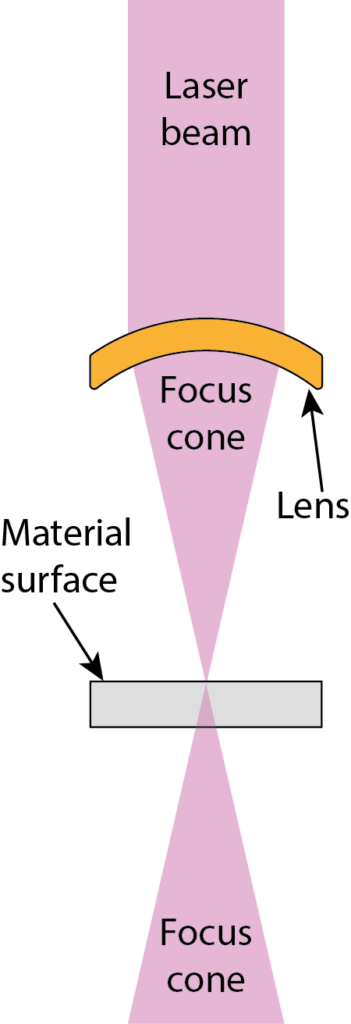Lasers are those famously parallel beams of light that go on forever right? Well sort of and in many cases they’re fantastic for super accurate measuring applications, line-of-sight comms links and all sort of other stuff. If you have a laser level in your DIY box you’ll immediately get this.
So why does it need to be focused?
To cut/engrave material you need to direct all the energy of the beam into a really small spot, directly analogous to using a magnifying glass to burn a hole in paper on a bright day. With the magnifying glass, say a 10cm round one, when you focus the sun onto that little dot you’re taking that 10cm of energy and putting it all onto a 1mm dot on the paper. That’s 7854mm2 of sun condensed onto 3.1mm2, a 2500x increase in energy for the area. When you see it put like that you can see why the paper burns!

Likewise with a laser you want the smallest spot you can get to concentrate all the energy into that dot and of course to get a nice, fine cutting edge or great resolution for engraving.
A typical laser dot is around 0.08-0.1mm in diameter but the beam from the laser tube itself is around 1cm in diameter so a lens is used to focus that 1 cm into a spot of 0.01cm. Unsurprisingly this cuts and engraves very well!
When engraving you want to focus the beam onto the surface of the material but if you’re cutting, particularly on thicker material like 12 or 18mm MDF, you want to focus the beam a little below the surface. Why is this you ask? A simple diagram will explain! As you see, because the beam is focused it’s now a cone shape which means the power for the area varies outside of the focal point. If you focused on the surface of the 12mm MDF your beam would be out of focus by quite a bit on the underside of the material. By moving the focus closer to the centre of the material you’re a little out at the surface and the underside still, but far less than you would have been overall by focusing on the surface. You also get a slightly straighter edge to the cut overall due to the ‘cone’ of the laser being narrower across the depth of the cut. For regularly cutting thicker materials you can actually use a different lens with a longer focal length which gives you a narrower cone (but slightly lower engraving quality) and also allows you somewhat greater positioning freedom when you want to focus lower into the material as a standard lens only gives you about 4mm freedom with the focus before it bumps into the surface.

We hope you found this interesting (and maybe even useful) – now you know why lasers sometimes need to be focused! Take a moment to see how this understanding is used to create the great things we make in our gallery and of course always make sure to get in touch if you have something that you’d like created.
| Cookie | Duration | Description |
|---|---|---|
| cookielawinfo-checkbox-analytics | 11 months | This cookie is set by GDPR Cookie Consent plugin. The cookie is used to store the user consent for the cookies in the category "Analytics". |
| cookielawinfo-checkbox-functional | 11 months | The cookie is set by GDPR cookie consent to record the user consent for the cookies in the category "Functional". |
| cookielawinfo-checkbox-necessary | 11 months | This cookie is set by GDPR Cookie Consent plugin. The cookies is used to store the user consent for the cookies in the category "Necessary". |
| cookielawinfo-checkbox-others | 11 months | This cookie is set by GDPR Cookie Consent plugin. The cookie is used to store the user consent for the cookies in the category "Other. |
| cookielawinfo-checkbox-performance | 11 months | This cookie is set by GDPR Cookie Consent plugin. The cookie is used to store the user consent for the cookies in the category "Performance". |
| viewed_cookie_policy | 11 months | The cookie is set by the GDPR Cookie Consent plugin and is used to store whether or not user has consented to the use of cookies. It does not store any personal data. |